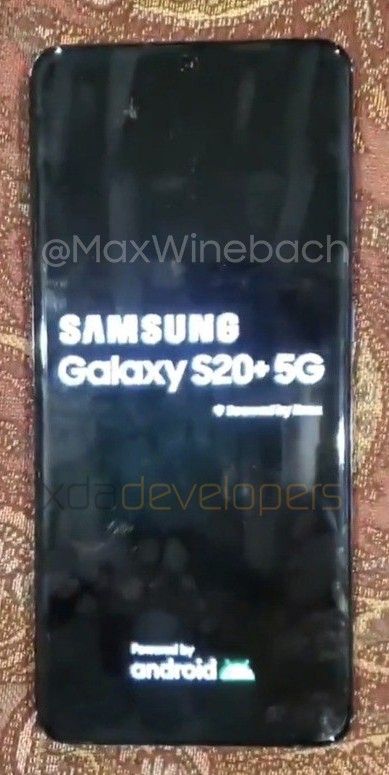The next major smartphone launch event for Samsung, Samsung Unpacked 2020 is just a few weeks away. On February 11th, Samsung is expected to unveil the Galaxy S20 trio of flagship smartphones as well as a new clamshell foldable smartphone. As we approach the launch event, we’ve already seen a few live images of the alleged Galaxy Z Flip foldable phone and a few CAD-based renders of the Galaxy S20 series. However, to date, we haven’t seen any leaks of the Galaxy S20 in the wild. Today, we are fortunate enough to bring to you the first live images of Samsung’s 2020 flagship. This is the Samsung Galaxy S20+.


The pictures above were sent to me by a source who wishes to stay anonymous. Some edits have been made to the image to protect the source, but none of the edits impact our ability to see the design of the Galaxy S20+. In the image of the rear, the first thing that stands out to us is the camera setup. We can see a total of 4 cameras, a flash, and what looks like a microphone hole. On the right side of the phone, we can see a volume rocker and a power button. There is no Bixby button unlike in the earlier S10 series.
The front of the display shows us very small bezels. The Infinity-O display is much less curved than before. Our source said it felt flat – almost similar to the Pixel 2 XL, in fact. Samsung appears to have opted for 2.5D glass instead of their usual curved glass. The hole punch is centered and smaller than the Galaxy Note 10. Just like the Galaxy S10 and Galaxy Note 10, the Galaxy S20+ will come with a pre-installed screen protector.
We’ve referred to this phone as the Galaxy S20+ thus far, which if you’re familiar with Samsung’s S series nomenclature, means this phone will be the highest-end model. That’s actually not the case this year. This phone is expected to be in the middle of the S20 series. It will be slightly larger than the regular Galaxy S20 but it will lack the camera technology present in the higher-end “Galaxy S20 Ultra”. This particular model is rumored to come with a new 12MP 1.8μm main image sensor. Samsung is also throwing in an ultra-wide, telephoto, and likely macro lens. The microphone on the rear could help with Samsung’s zoom-in mic feature. It could also just help improve audio quality in videos in general, which I found to be a weak point on the Galaxy Note 10.

The Galaxy S20 and S20+ are expected to launch in a few different variants around the world. There will be the 4G Galaxy S20, 5G Galaxy S20, 4G Galaxy S20+, and 5G Galaxy S20+. The 5G and 4G LTE variants of these devices will look the same, but I believe the U.S. market will only be getting the 5G variants. I can’t speak about the specifics of network connectivity just yet, but given that the device, at least in the U.S., will pack the Qualcomm Snapdragon 865 mobile platform (which can only be paired with the Snapdragon X55 modem), it should support the sub-6GHz networks of Sprint, AT&T, and T-Mobile. Since we expect the phone to launch on Verizon as well, it’s likely the device packs mmWave antennas to support Verizon’s Ultra Wideband (mmWave) network. Outside of the U.S., the phone is expected to pack the Exynos 990 SoC. Whether or not the S20 that launches in your country will have 5G enabled will depend on whether or not 5G network support is launched in your country.
These devices, and the leaks about them, are very exciting. Samsung’s flagships for the year are some of the most interesting Android smartphones. We are going to hear a lot more about the S20 series and the new foldable phone at Samsung Unpacked on February 11th. I will be there covering the event for the XDA Portal and XDA TV, so make sure to keep an eye out for more information to come.
Samsung Galaxy S20 Forums ||| Samsung Galaxy S20+ Forums
The post Exclusive: This is the Samsung Galaxy S20+ appeared first on xda-developers.
from xda-developers https://ift.tt/3a0ZICc
via
IFTTT



